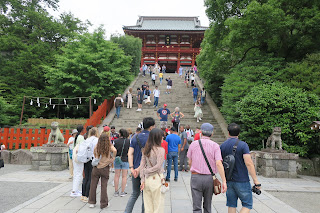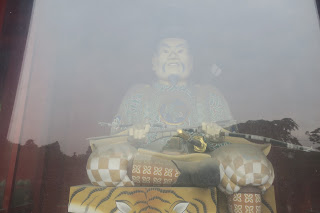Tsurugaoka Hachiman-gu is the most important Shinto shrine in the city of
Kamakura, Kanagawa Prefecture, Japan.
For most of its history, it served both as a Hachiman shrine, and in latter
years a Tendai Buddhist temple typical of Japanese Buddhist architecture.
This shrine was originally built in 1063 as a branch of Iwashimizu Shrine in
Zaimokuza where tiny Moto Hachiman now stands and dedicated to the Emperor
Ojin, (deified with the name Hachiman, tutelary kami of warriors), his mother
Empress Jingu and his wife Hime-gami.
Minamoto no Yoritomo, the founder of the Kamakura shogunate, moved it to its
present location in 1191 and invited Hachiman to reside in the new location to
protect his government.
|
Tsurugaoka Hachiman-gu map.
An unusual feature of the shrine is its 1.8 km (1.1 mi) approach
(sando), which extends all the way to the ocean in Yuigahama and doubles
as Wakamiya Oji Avenue, Kamakura's main street. Built by Minamoto no
Yoritomo as an imitation of Kyoto's Suzaku Oji, Wakamiya Oji used to be
much wider and flanked by both a 3 m (9.8 ft) deep canal and pine trees.
-
Walking from the beach toward the shrine one passes through three
torii, or Shinto gates. Between the first and the second lies Geba
Yotsukado which, as the name indicates, was the place where riders had
to get off their horses in deference to Hachiman and his shrine.
-
Some hundred meters further, between the second and third torii,
begins the dankazura, a raised pathway flanked by cherry trees.
The dankazura becomes gradually wider so that, seen from the
shrine, it will look longer than it really is. The entire length of
the dankazura is under the direct administration of the shrine.
|
|
Third Torii (San-no Torii).
There is a 1.8 km (1.1 mi) straight street in the front of shrine,
called Wakamiya Oji. It is the approach (sando) of Tsurugaoka
Hachiman-gu, there are three big Shinto gates (Torii).
-
The Torii gate farthest from the shrine is called the First Torii
(Ichi-no-Torii), the one in the middle is the Second Torii
(Ni-no-Torii) and the one in front of the shrine is the Third Torii
(San-no-Torii).
|
|
Arched Bridge (Taiko-bashi).
As one enters, after the Third Torii (San-no-Torii) there are three
small bridges, two flat ones on the sides and an arched one at the
center.
-
In the days of the shogunate there used to be only two, a normal one
and another arched, made in wood and painted red.
-
The shogun would leave his retinue there and proceed alone on foot to
the shrine.
-
The arched bridge was called Red Bridge (Akabashi), and was reserved
to him: common people had to use the flat one.
-
The bridges span over a canal that joins two ponds popularly called
Genpei-ike, or "Genpei ponds". The term comes from the names of the
two families, the Minamoto ("Gen") and the Taira ("Pei"), that fought
each other in Yoritomo's day.
|
|
Entrance to Hataage Benzaiten Shrine.
One of the islands in the Minamoto pond hosts a sub-shrine called
Hataage Benzaiten Shrine dedicated to goddess Benzaiten, a Buddhist
deity.
-
For this reason, the sub-shrine was dismantled in 1868 at the time of
the "Shinto and Buddhism separation" order (see below) and rebuilt in
1956.
|
|
Water ablution pavilion (Chozuya).
Chozu-ya or temizu-ya is a Shinto water ablution pavilion for a
ceremonial purification rite known as temizu or chozu
(lit. 'hand-water'). The pavilion contains a large water-filled basin
called a chozubachi ('hand water basin').
-
At shrines, these chozubachi are used by worshippers for washing their
left hands, right hands, mouth and finally the handle of the water
ladle to purify themselves before approaching the main Shinto shrine
or shaden.
-
This symbolic purification is normal before worship and all manned
shrines have this facility, as well as many Buddhist temples and some
new religious houses of worship.
-
See more at
Chōzuya - Wikipedia.
|
|
Dance Stage (Lower Oratory) (Maiden).
Right under the stairway there's an open pavilion called Maiden where
weddings, dances and music are performed.
|
|
Sake barrels.
When displayed near a Shinto shrine, barrels of sake are called
kazaridaru, which means “decoration barrels.” As can be surmised,
the barrels on display are empty, at least in physical terms.
Spiritually, they’re chock full of significance.
-
In Japan, sake has always been a way of bringing our gods and people
together.
-
In some of the oldest texts the word used for sake is miki,
written with the characters for ‘god’ and ‘wine.’ People would go a
shrine festival and be given rice wine to drink, and they would feel
happy and closer to the gods.
|
|
Outdated Amulet Return.
Omamori are Japanese amulets commonly sold at Shinto shrines and
Buddhist temples, dedicated to particular Shinto kami as well as
Buddhist figures, and are said to provide various forms of luck and
protection.
-
Customarily, omamori are not opened in order to avoid losing their
protective benefits.
-
They are instead carried on one's person, or tied to something like a
backpack or a purse.
-
It is not necessary, but amulets are customarily replaced once a year
to ward off bad luck from the previous year.
-
Old amulets are usually returned to the same shrine or temple they
were purchased at so they can be disposed of properly.
-
Amulets are commonly returned on or slightly after New Year's. This
way the shrine/temple visitor has a fresh start for the New Year with
a new omamori.
-
Old omamori traditionally should not be disposed of, but burned, as a
sign of respect to the deity that assisted the person throughout the
year.
-
See more at
Omamori - Wikipedia.
|
|
Giant ginkgo (Shizukazakura).
The ginkgo tree that stood next to Tsurugaoka Hachiman-gu's stairway
almost from its foundation and which appears in almost every old print
of the shrine was completely uprooted and greatly damaged at 4:40 in the
morning on March 10, 2010.
-
According to an expert who analyzed the tree, the fall is likely due
to rot. Both the tree's stump and a section of its trunk replanted
nearby have produced leaves.
-
The tree was nicknamed Hiding Ginkgo (kakure-icho) because according
to an Edo period urban legend, a now-famous assassin hid behind it
before striking his victim.
|
|
Grand Stairway with 61 steps (Dashiduan).
One of the historical events the shrine is tied to is the assassination
of Sanetomo, last of Minamoto no Yoritomo's sons.
-
Under heavy snow on the evening of February 12, 1219 (Jokyu 1, 26th
day of the 1st month), shogun Minamoto no Sanetomo was coming down
from Tsurugaoka Hachiman-gu's Senior Shrine after assisting to a
ceremony celebrating his nomination to Udaijin. His nephew Kugyo, son
of second shogun Minamoto no Yoriie, came out from next to the stone
stairway of the shrine, then suddenly attacked and assassinated him in
the hope to become shogun himself.
-
The killer is often described as hiding behind the giant ginkgo, but
no contemporary text mentions the tree, and this detail is likely an
Edo-period invention first appeared in Tokugawa Mitsukuni's Shinpen
Kamakurashi.
-
For his act Kugyo was himself beheaded a few hours later, thus
bringing the Seiwa Genji line of the Minamoto clan and their rule in
Kamakura to a sudden end.
|
|
Senior Shrine gate (Hongu).
Tsurugaoka Hachiman-gu is now just a Shinto shrine but, for the almost
700 years from its foundation until the Shinto and Buddhism Separation
Order of 1868, its name was Tsurugaoka Hachimangu-ji and it was also a
Buddhist temple, one of the oldest in Kamakura.
-
The separation policy (shinbutsu bunri) was the direct cause of
serious damage to important cultural assets. Because mixing the two
religions was now forbidden, shrines and temples had to give away some
of their treasures, thus damaging the integrity of their cultural
heritage and decreasing the historical and economic value of their
properties.
-
Tsurugaoka Hachiman's giant Nio (the two wooden wardens usually found
at the sides of a temple's entrance), being objects of Buddhist
worship and therefore illegal where they were, had to be sold to
Jufuku-ji, where they still are.
-
The shrine also had to destroy Buddhism-related buildings, for example
its shichido garan (a complete seven-building Buddhist temple
compound), its tahoto tower, and its mido (enshrinement
hall (of a buddha)).
-
In important ways, Tsurugaoka Hachiman-gu was impoverished in 1868 as
a consequence of this Meiji Era policy.
|
|
Two guardian archers.
Two shinto guardian archers sitting at either side of the main gate.
-
Tsurugaoka Hachiman-gu is the center of much cultural activity and
both archery from horseback (yabusame), and Japanese archery (kyudo)
are practiced within the shrine.
-
See more at
Kyūdō - Wikipedia.
|
|
Senior Shrine (Hongu).
A Hachiman shrine (Hachiman Jinja, also Hachiman-gu) is a Shinto shrine
dedicated to the kami Hachiman.
-
It is the second most numerous type of Shinto shrine after those
dedicated to Inari Okami. There are about 44,000 Hachiman shrines.
-
Originally the name was read Yawata or Yahata, a reading still used in
some cases. Many towns and cities incorporating the names Hachiman,
Yawata or Yahata grew around these shrines.
-
The following four shrines are often grouped into groups of three,
either as Usa-Iwashimizu-Hakozaki or Usa-Iwashimizu-Tsurugaoka, and
both of these groupings are known as the Three Major Hachiman Shrines
of Japan: Usa Jin-gu (Usa, Oita), the Sohonsha (head shrine);
Iwashimizu Hachiman-gu (Yawata, Kyoto); Hakozaki Shrine (Fukuoka);
Tsurugaoka Hachiman-gu (Kamakura).
-
See more at
Hachiman shrine - Wikipedia.
|
|
Leaving Tsurugaoka Hachiman-gu.
|
See also
Source
Location




























